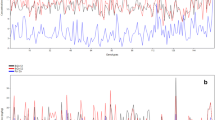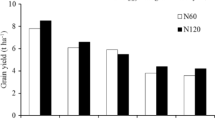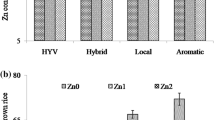Abstract
Background and aims
The loss of iron and zinc during milling to produce white rice can have serious consequences for human health. Therefore, the objective was to evaluate Fe and Zn partitioning between the endosperm, bran and embryo, and the milling loss of these nutrients among Thai rice genotypes.
Methods
Concentrations of iron and zinc and their partitioning to different parts of the grain were examined in 15 genotypes of Thai rice (10 belonging to the long-slender grain type) grown together under wetland condition.
Results
The depression in grain Fe and Zn concentrations (24–60 and 10–58 %, respectively) on milling differed among rice genotypes and were affected by the extent of differential partitioning of Fe and Zn into different parts of the grain. For example, nearly 70 % of white rice Zn was allocated to the endosperm in contrast to only 43 % for Fe.
Conclusions
Because of variation in milling loss of Fe and Zn, that can result from genotypic variation in the degree of milling and partitioning of Fe and Zn into different parts of the grain, we conclude that white rice Fe and Zn concentrations should not be inferred solely from brown rice concentrations of these nutrients.





Similar content being viewed by others
References
Allan JE (1961) The determination of zinc in agricultural material by atomic absorption spectrophotometry. Analyst 96:531–534
Cakmak I (2008) Enrichment of cereal grains with zinc: agronomic or genetic biofortification? Plant Soil 302:1–17
Cakmak I, Kalayci M, Kaya Y, Torun AA, Aydin N, Wang Y, Arisoy Z, Erdem H, Yazici A, Gokmen O, Ozturk L, Horst WJ (2010) Biofortification and localization of zinc in wheat grain. J Agric Food Chem 58:9092–9102
Fang Y, Wang L, Xin Z, Zhao L, An X, Hu Q (2008) Effect of foliar application of zinc, selenium, and iron fertilizers on nutrient concentration and yield of rice grain in China. J Agric Food Chem 56:2079–2084
FAO/WHO (1998) Vitamin and mineral requirements in human nutrition: report of a joint FAO/WHO expert consultation, Bangkok, Thailand, 21–30 September 1998
Goodman DE, Rao RM (1985) Effect of grain type and milled rice kernel hardness on the head rice yields. J Food Sci 50:840–842
Graham RD, Senadhira D, Beebe S, Iglesias C, Monasterio I (1999) Breeding for micronutrient density in edible portions of staple food crops: conventional approaches. Field Crop Res 60:57–80
Hotz C, Brown KH (2004) Assessment of the risk of zinc deficiency in populations and options for its control. Food Nutr Bull 25:94–204
Jongkaewwattana S, Geng S (2002) Non-uniformity of grain characteristics and milling quality of California rice (Oryza sativa L.) of different maturities. J Agron Crop Sci 188:161–167
Juliano BO (1993) Rice in human nutrition. Food and agriculture organization of the United Nations, Rome
Leesawatwong M, Jamjod S, Kuo J, Dell B, Rerkasem B (2005) Nitrogen fertilizer increases seed protein and milling quality of rice. Cereal Chem 82:588–593
Liang J, Li Z, Tsiji K, Nakano K, Nout R, Hamer RJ (2007) Milling characteristics and distribution of phytic acid and zinc in long-, medium- and short-grain rice. J Cereal Sci 48:83–91
Murphy J, Riley JP (1962) A modified single solution method for the determination of phosphate in natural waters. Anal Chim Acta 27:31–36
Nestel P, Bouis HE, Meenakshi JV, Pfeiffer W (2006) Biofortification of staple food crops. J Nutr 136:1064–1067
Palawisut S, Nualsiri P, Patirupanusara P, Patirupanusara T, Noenplab ANL, Chiengwattana N, Pattawatang P, Suwanthada S, Chairinte S, Suttayot S, Anawong J, Palawisut W, Intrarasatit W, Wannasai C, Ariyapruek D, Hintang P, Wangka M, Deerasamee C, Sanguansaj T, Varamisara V, Karnjanaphun S, Pipatpiriyanon J, Kongtong T, Sriratanasak W, Chansrisommai N, Tayatum C, Chettanachit D, Nilpanit N (2008) RD29 (Chainat 80) rice variety. Thai Rice Res J 2:80–95
Phattarakul N, Rerkasem B, Li LJ, Wu LH, Zou CQ, Ram H, Sohu VS, Kang BS, Surek H, Kalayci M, Yazici A, Zhang FS, Cakmak I (2012) Biofortification of rice grain with zinc through zinc fertilization in different countries. Plant Soil. doi:10.1007/s11104-012-1211-x
Prom-u-thai C, Sanchai C, Rerkasem B, Jamjod S, Fukai S, Godwin ID, Huang L (2007a) The effect of grain morphology on degree of milling and iron loss in rice. Cereal Chem 84:384–388
Prom-u-thai C, Fukai S, Godwin ID, Huang L (2007b) Genotypic variation of iron partitioning in rice grain. J Sci Food Agric 87:2049–2054
Ren X, Liu Q, Fu H, Wu D, Shu Q (2006) Variations in concentration and distribution of health-related elements affected by environmental and genotypic differences in rice grains. Rice Sci 13:170–178
Resurreccion PA, Juliano BO, Tanaka Y (1979) Nutrient content and distribution in milling fractions of rice grain. J Sci Food Agric 30:475–481
Senadhira D, Gregorio GB, Graham RD (1998) Breeding Fe and Zn dense rice. Los Banos, Laguna, Philippines, IRRI
Sison MEGQ, Gregorio GB, Mendioro MS (2006) The effect of different milling times on grain iron content and grain physical parameters associated with milling of eight genotypes of rice (Oryza sativa). Phil J Sci 135:9–17
Sun H, Siebenmorgan TJ (1993) Milling characteristics of various rough rice kernel thickness fractions. Cereal Chem 70:727–733
Thurlow RA, Winichagoon P, Pongcharoen T, Gowachirapant S, Boonpraderm A, Manger MS, Bailey KB, Wasantwisut E, Gibson RS (2006) Risk of zinc, iodine and other micronutrient deficiencies among school children in North East Thailand. Eur J Clin Nutr 60:623–632
Wang KM, Wu JG, Li G, Zhang DP, Zhong WY, Shi CH (2011) Distribution of phytic acid and mineral elements in three indica rice (Oryza sativa L.) genotypes. J Cereal Sci 54:116–121
Welch RM, Graham RD (2002) Breeding crops for enhanced micronutrient content. Plant Soil 245:205–214
WHO (2002) World health report 2008. World Health Organization, Geneva
Acknowledgements
The first author is a recipient of a Royal Golden Jubilee PhD scholarship. Support from Research University Project of Thailand’s Commission of Higher Education is also gratefully acknowledged. We thank Dr. Sittichai Lordkaew, Chiang Mai University for help with chemical analysis.
Author information
Authors and Affiliations
Corresponding author
Additional information
Responsible Editor: Ismail Cakmak.
Rights and permissions
About this article
Cite this article
Saenchai, C., Prom-u-thai, C., Jamjod, S. et al. Genotypic variation in milling depression of iron and zinc concentration in rice grain. Plant Soil 361, 271–278 (2012). https://doi.org/10.1007/s11104-012-1228-1
Received:
Accepted:
Published:
Issue Date:
DOI: https://doi.org/10.1007/s11104-012-1228-1




